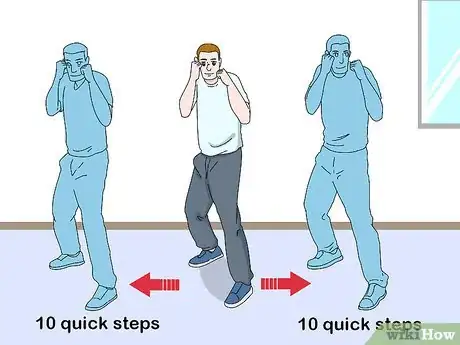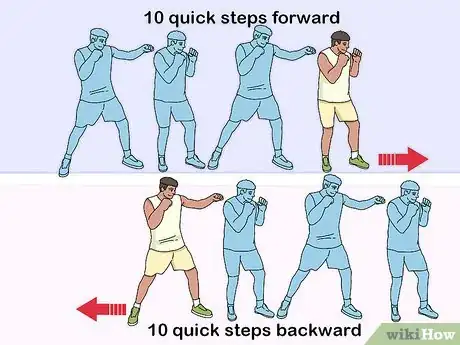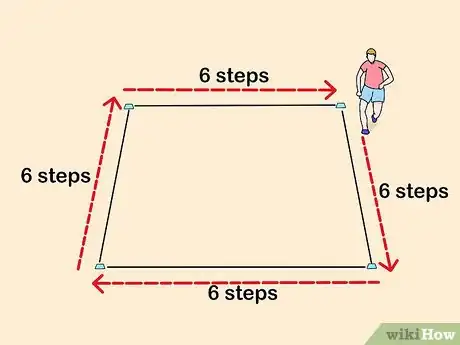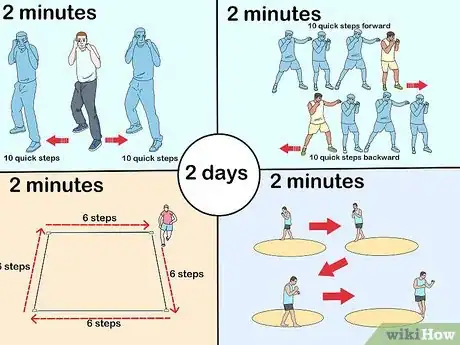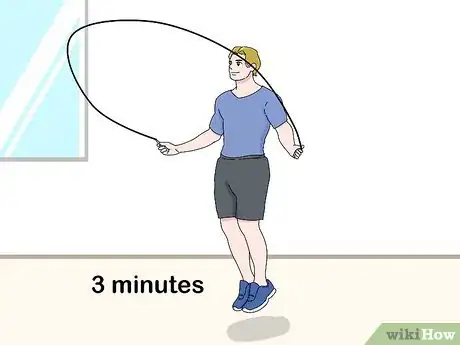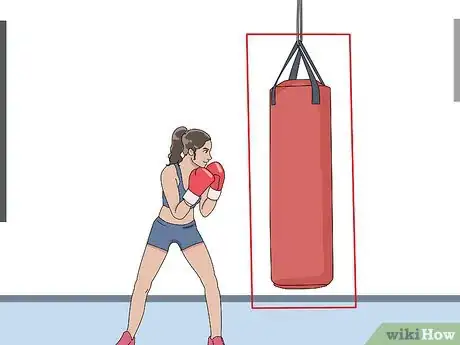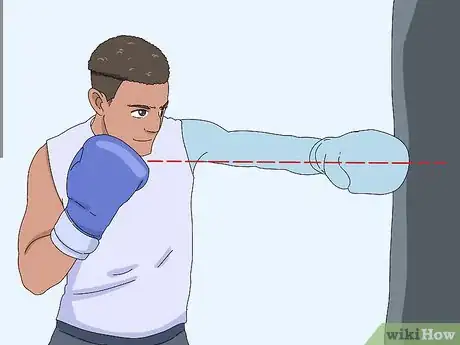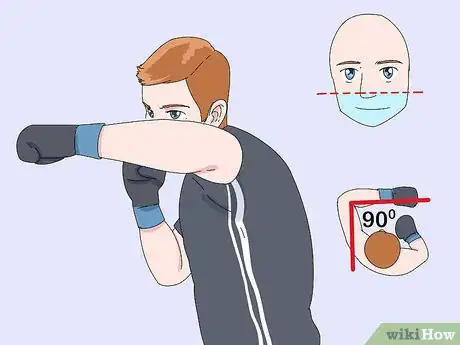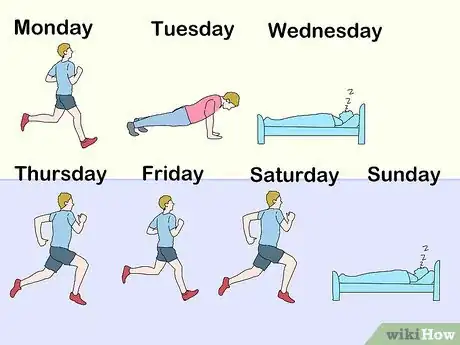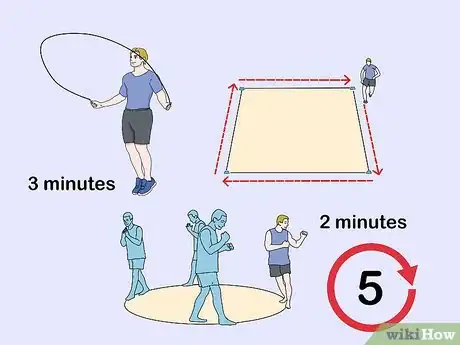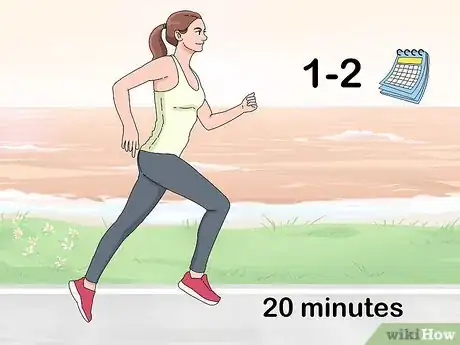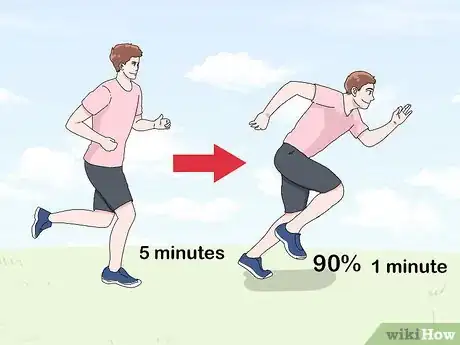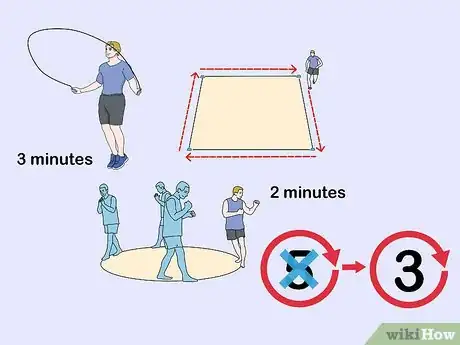This article was co-authored by David Engel. David Engel is a Muay Thai Instructor and Self Defense Trainer based in the San Francisco Bay Area. With over 15 years of martial arts instruction and training experience, David runs California Martial Athletics with co-owner Joe Chernay. He has created and maintained martial arts programs at Rise Combat Sports in San Francisco and Round 5 Martial Arts Academy in San Leandro, with a mission to provide students with a level of comfort and competency that manifests both within and outside the martial arts context. He is also a registered cornerman for amateur and pro competitors under the IKF (International Kickboxing Federation). David was the youngest apprentice instructor of the Thai Boxing Association of America under Ajarn Chai Sirisute (2009), and was a top-ranked amateur competitor in his weight class (127-130 lb) in California between 2013 and 2015.
This article has been viewed 23,406 times.
Intensity is the key to a boxer’s training, which usually involves a mix of aerobic exercise, agility and punching drills, and strength training. To really train like a boxer, learn how to throw individual punches and put them together in combination drills. Even if you’re not planning on landing and taking punches in the ring, you can develop a workout routine around cardio, agility, and strength training. Tailor your routine to your abilities, and organize your training exercises in a weekly schedule.
Steps
Getting Your Footwork in Gear
-
1Master your boxing stance. Stand with your legs shoulder width apart, your knees slightly bent, and your weight on the balls of your feet. If you’re right-handed, your left leg should be forward and your right leg back, so it can power your dominant hand’s punches. If you’re left-handed, keep your right leg in front.[1]
- With your elbows bent at 90 degree angles, bring your dominant fist close to your chin and your lead fist to cheek height. Keep your elbows tucked in close to your chest.
-
2Perform side step drills. Start in your boxing stance, then take 10 quick shuffle steps to the left and 10 steps to the right. Push off your right foot when you step to the left, and off your left foot when you step to the right.[2]Advertisement
-
3Do forward and backward drills. Start in your boxing stance and take 10 quick steps forward, then 10 steps back. Push off of your back foot when you step forward, and off your lead foot when you step back.[3]
-
4Do box drills. Combine left, right, forward, and backward steps to do a box drills. Move 6 steps forward, 6 steps right, 6 steps back, and 6 steps left. After 4 boxes, switch directions by moving back, left, forward, and right.[4]
-
5Do circle drills. Push off your the leg opposite your step’s direction like you did with your left, right, forward, and back steps. Instead of moving in a straight line, move in an arc to make a complete circle. Place an object on the floor to help you keep track of your circle.[5]
- Change directions after you complete a circle.
-
6Do 4 sets each of your foot drills on boxing days. Your weekly split will include at least 2 days dedicated to boxing. Before practicing your punch combinations on those days, do a 2 minute set of left and right steps, a 2 minute set of forward and backward steps, a 2 minute set of box steps, and a 2 minute set of circle steps. Rest for 30 seconds between each set, then repeat the sequence to complete 4 sets of each drill.[6]
-
7Jump rope to build endurance and agility. Boxers jump rope because it’s great for endurance, builds coordination, and works the calves. Do 3 sets of jumping rope for 3 minutes, and rest for 30 seconds between each set. Work your sets in at the beginning and end of your boxing workout day.[7]
- Jumping rope will help you improve both your balance and your defense skills, such as bobbing and weaving.[8]
Practicing Punch Combinations
-
1Train with a heavy bag if you can only get one bag. Heavy bags are the most commonly used boxing bag. If you don’t have access to a gym and want to purchase a bag, a heavy bag is your best option.
- If you have access to a gym or can splurge on more equipment, get a speed bag and an uppercut bag, too. You hit a speed bag with the sides and heels of your fist in quick, rhythmic rotations. An uppercut bag is shorter than a heavy bag, allowing you to properly throw an uppercut punch.
-
2Jab at chin height with your lead, non-dominant hand. As you throw the punch straight out at chin height, dip your head slightly and tuck in your chin toward your chest.
- A jab is a quick punch that sets up other punches.
- You can add more power to a jab by stepping forward with your lead foot.
-
3Throw a cross with your rear, dominant hand. Throw the cross punch with your dominant hand, and use your back leg to generate force. Drive off of your back foot, rotate your dominant shoulder and hip forward, and throw your dominant arm and fist straight forward at chin height.[9]
-
4Hook with your lead hand. Hooks are typically thrown with the lead fist, as a hook thrown with a dominant fist can leave you more vulnerable. Raise your lead elbow to face height and keep it bent at a 90 degree angle. Tuck it close to your body at around shoulder width, and make a compact punch from the side. Rotate your hips and torso in the direction of the punch to generate force.[10]
-
5Work on mastering the uppercut. Bend your dominant knee and twist your body downward so your it’s almost parallel with the floor. Keep your elbow bent at a 90 degree angle, and dip your throwing arm backward so the heel of your fist faces upward and is roughly in line with your lower chest. Rotate your hips and torso up and forward, and thrust your fist up to land the punch on your opponent’s chin (or training bag). Use the rotation of your torso and your dominant leg to power your punch.
- The uppercut is powerful and more difficult to master than other basic punches.
- You can also throw an uppercut with your non-dominant hand.
-
6Practice combination drills. Once you’ve nailed individual punches, you can work on doing 3 minute rounds of combination drills. Each punch is assigned a number: a jab is 1, a cross is 2, and a hook is 3. If you’ve mastered the uppercut as well, label an uppercut thrown with your dominant first 4 and non-dominant 5. Try these basic combinations:[11]
- 1-2-3, or jab-cross-hook, is a simple combination in which each punch sets up the next.
- 1-3, or jab-hook, builds hand coordination, as both punches are thrown with the same fist.
- 2-3-2, or cross-hook-cross, is a power combination that helps you practice landing power without a jab set up.
- 1-2-5-2, or jab-cross-non-dominant uppercut-cross, is a power combination that aims to surprise your opponent, who might be expecting a hook instead of an uppercut.
- 1-4-2, or jab-dominant uppercut-cross, adds unpredictability by mixing in an uppercut after the jab instead of a cross.
Creating a Training Schedule
-
1Schedule your training exercises in a weekly split. Your weekly split, or training schedule, organizes the individual parts of your training. When you're starting out, you should train 3 times a week, and do 2 days of independent exercise like running or cycling. [12] Assign specific days for cardio workouts, agility and combination drills, weight training, and active rest activities. Your routine could look like this:
- Monday: Slow long distance run, boxing workout (foot and combination drills).
- Tuesday: Upper body weight training (such as 4-5 sets of 15-20 push-ups and sit-ups, 2 sets of 10 pull-ups, or a circuit of upper body resistance weight training machines).
- Wednesday: Rest (optional: yoga, Tai Chi, or light aerobic activity).
- Thursday: High intensity interval runs, boxing workout (foot and combination drills).
- Friday: Slow long distance run, lower body weight training (such as 3 sets of 5 weighted squats, 3 sets of 10 to 15 weighted calf raises, 2 sets of 20 weighted lunges, or a circuit of lower body resistance weight training machines).
- Saturday: High intensity interval runs, boxing workout (foot and combination drills).
- Sunday: Rest (optional: yoga, Tai Chi, or light aerobic activity).
-
2Do 5 rounds of combination drills and foot drills on boxing days. On your weekly split’s boxing days, start with jumping rope for 3 sets of 3 minutes to warm up. Perform 4 sets of 2 minute foot drills (4 sets each of left, right, forward, backward, box, and circle foot drills). Do 5 rounds of combination drills at 3 minutes per round, then cool down with another jump rope routine.[13]
- You can do 1 combination per round (1-2-3 for an entire round and 1-3 for another whole round), or mix up multiple combinations in a single round.
- Rest less than 30 seconds between activities.
-
3Do a slow long distance run 1 to 2 times per week. Build your endurance by running for as long as you can. If you’re in great aerobic shape, you might be able to go 90 minutes. If you’re not used to long distance runs, start with light jogging for 20 minutes.[14]
- Your pace shouldn’t be too intense. The Talk Test is a good way to gauge your run’s intensity. You should be able to use complete phrases, but have to take a deep breath between phrases. If you’re too winded to speak, your pace is too intense. If you don’t have to take deep breaths, you should run harder.
- Vary long-distance running and sprints in your boxing workouts. Long-distance runs will improve your footwork, endurance, and recovery. Sprints, especially on an incline, will help prepare you for the quick exchanges and chaos that happen when you're fighting.[15]
-
4Include 2 days of interval training in your workout routine. High intensity interval training involves alternating periods of intense running with active recovery. Warm up by jogging lightly for 5 minutes, then run at about 90 percent of your maximum speed for 1 minute. Actively recover by jogging for 2 to 3 minutes, then do another 90 percent interval.
- Include 6 to 8 seconds of intense sprints in your 90 percent intervals.
- Do 20 minutes of interval training, including 5 minutes of easy jogging to cool down.
-
5Add an aerobic activity to mix up your cardio routine. Add variety to your routine with 1 to 2 hours of an aerobic activity, such as swimming, cycling, rowing, or hiking. You can do an aerobic activity instead of a run or do one on an active rest day.[16]
- An active rest day is incorporated in weekly splits to stimulate the recovery process. It gives you a break from more intense workouts, but helps you stay in gear for your next day of training.
-
6Include strength training in your routine. In addition to cardio, agility, and combination drills, include strength training workouts at least 2 days per week. Perform upper body, core, and lower body exercises, including push-ups, sit-ups, pull-ups, squats, lunges, and calf raises.
- Focus on 1 section of your body per day, such as upper body on Tuesdays and legs on Thursdays.
-
7Do yoga or Tai Chi on active rest days. In addition to swimming and other aerobic activities, yoga and Tai Chi are excellent active rest options. They can help you sharpen your focus, develop breath control, and improve flexibility.[17]
- Find a local yoga or Tai Chi studio, take classes at your gym or YMCA, or look online for instructional videos.
- If possible, use resistance exercise machines at home or the gym.
-
8Consult your doctor before starting an exercise program. Boxers train at a high level, so ask your doctor if a routine that involves intense aerobic exercise is right for you. It’s especially important to talk to your doctor if you have a history of heart, bone, joint, or other medical issues.[18]
-
9Tailor your training schedule to your abilities. Don’t push yourself beyond your limits, and decrease intensity if you’re just starting to train. For example, instead of doing 5 rounds of combination drills, do 3 rounds and take a longer break between each set.[19]
- Do 20 minute long slow distance runs instead of 90 minute runs, and 7 to 12 minutes of high intensity interval training instead of 20.
- If you’re more advanced, do multiple activities in a single day, such as a slow long distance run and boxing drills on Mondays. If you’re a beginner, do a single activity per day.
- Additionally, if you don’t need to actually box or practice combinations, substitute boxing days with a weight training day and aerobic activity day.
Expert Q&A
-
QuestionHow do I know when it's time to start sparring?
 David EngelDavid Engel is a Muay Thai Instructor and Self Defense Trainer based in the San Francisco Bay Area. With over 15 years of martial arts instruction and training experience, David runs California Martial Athletics with co-owner Joe Chernay. He has created and maintained martial arts programs at Rise Combat Sports in San Francisco and Round 5 Martial Arts Academy in San Leandro, with a mission to provide students with a level of comfort and competency that manifests both within and outside the martial arts context. He is also a registered cornerman for amateur and pro competitors under the IKF (International Kickboxing Federation). David was the youngest apprentice instructor of the Thai Boxing Association of America under Ajarn Chai Sirisute (2009), and was a top-ranked amateur competitor in his weight class (127-130 lb) in California between 2013 and 2015.
David EngelDavid Engel is a Muay Thai Instructor and Self Defense Trainer based in the San Francisco Bay Area. With over 15 years of martial arts instruction and training experience, David runs California Martial Athletics with co-owner Joe Chernay. He has created and maintained martial arts programs at Rise Combat Sports in San Francisco and Round 5 Martial Arts Academy in San Leandro, with a mission to provide students with a level of comfort and competency that manifests both within and outside the martial arts context. He is also a registered cornerman for amateur and pro competitors under the IKF (International Kickboxing Federation). David was the youngest apprentice instructor of the Thai Boxing Association of America under Ajarn Chai Sirisute (2009), and was a top-ranked amateur competitor in his weight class (127-130 lb) in California between 2013 and 2015.
Muay Thai Instructor & Self Defense Trainer It's important not to start sparring too early. You want to make sure you work with your coach to develop good fundamentals first. Do pad work to improve your balance and control, and work with your coach to get rid of some of the beginning stage jitters like flinching and closing your eyes.
It's important not to start sparring too early. You want to make sure you work with your coach to develop good fundamentals first. Do pad work to improve your balance and control, and work with your coach to get rid of some of the beginning stage jitters like flinching and closing your eyes.
References
- ↑ http://www.mensfitness.com/training/workout-routines/train-boxer
- ↑ http://www.mensfitness.com/training/workout-routines/train-boxer
- ↑ http://www.mensfitness.com/training/workout-routines/train-boxer
- ↑ http://www.mensfitness.com/training/workout-routines/train-boxer
- ↑ http://www.mensfitness.com/training/workout-routines/train-boxer
- ↑ http://www.artofmanliness.com/2012/07/10/train-like-a-fighter-workout-1-cardio-plyometrics-and-agility-training/
- ↑ http://www.muscleandfitness.com/workouts/leg-exercises/videos/jump-rope
- ↑ David Engel. Muay Thai Instructor & Self Defense Trainer. Expert Interview. 5 May 2020.
- ↑ http://www.mensfitness.com/training/workout-routines/train-boxer
- ↑ http://www.mensfitness.com/training/workout-routines/train-boxer
- ↑ http://www.mensfitness.com/training/workout-routines/train-boxer
- ↑ David Engel. Muay Thai Instructor & Self Defense Trainer. Expert Interview. 5 May 2020.
- ↑ http://www.mensfitness.com/training/workout-routines/train-boxer
- ↑ http://www.artofmanliness.com/2012/07/10/train-like-a-fighter-workout-1-cardio-plyometrics-and-agility-training/
- ↑ David Engel. Muay Thai Instructor & Self Defense Trainer. Expert Interview. 5 May 2020.
- ↑ http://www.telegraph.co.uk/health-fitness/body/floyd-mayweather-training-plan-train-like-boxer/
- ↑ http://www.telegraph.co.uk/health-fitness/body/floyd-mayweather-training-plan-train-like-boxer/
- ↑ http://www.merckmanuals.com/home/fundamentals/exercise-and-fitness/starting-an-exercise-program
- ↑ http://www.mensfitness.com/training/workout-routines/train-boxer

